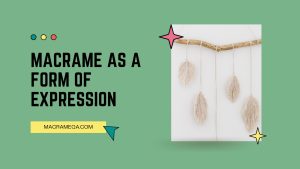Macrame, a beautiful form of textile art, has been practiced by various cultures around the world for centuries. From ancient civilizations to modern times, this intricate craft has evolved and developed distinctive features that represent the unique traditions and aesthetics of different cultures. With its intricate knotting techniques and creative use of materials, macrame reflects the rich cultural heritage and artistic expressions of communities from all corners of the globe. Whether it’s the delicate designs of the Middle East, the vibrant colors of South America, or the symmetrical patterns of Asia, each culture brings its flavor and style to this mesmerizing art form. Explore the fascinating world of macrame in different cultures and discover the beauty and diversity of this ancient craft.
Distinctive Features of Macrame in Different Cultures
Macrame, the art of knotting cords into intricate patterns, has been practiced in various cultures around the world for centuries. Each culture adds its unique elements and techniques to this ancient craft, resulting in distinctive features that make their macrame styles easily distinguishable. From Native American to African, Middle Eastern to South American, Asian to European, Oceanic to Indigenous, and finally to Modern Western and Contemporary Global cultures, let us explore the fascinating world of macrame through different cultural lenses.
Macrame in Native American Culture
Macrame holds great significance in Native American culture as it was used for both practical and decorative purposes. Native American macrame often incorporated natural materials like feathers, beads, and shells into their designs, reflecting the close connection between nature and their crafts. The patterns and motifs used in Native American macrame often featured symbols representing elements of their spirituality and tribal identity.
Macrame in Middle Eastern Culture
Middle Eastern macrame showcases a rich tapestry of intricate knotting techniques and lavish designs. Traditional Middle Eastern macrame is characterized by intricate geometric patterns and motifs such as flowers, stars, and arabesque designs. It often utilizes luxurious materials like silk, gold threads, and gemstones, creating a sense of opulence and grandeur.
Macrame in African Culture
African macrame is known for its bold and vibrant style, reflecting the vibrant cultures and traditions across the African continent. With a focus on bright colors and intricate weaving techniques, African macrame often incorporates natural materials like raffia, sisal, and dyed fibers. The designs frequently feature symbolic elements such as animals, tribal patterns, and cultural imagery, showcasing the rich heritage and storytelling traditions of African cultures.
Macrame in South American Culture
South American macrame is deeply rooted in the cultural heritage of indigenous communities. Each South American region has its unique macrame style, incorporating elements of its local flora, fauna, and traditional symbols. Macrame in South America often integrates materials like cotton, wool, and alpaca fibers, resulting in beautifully textured and durable creations. Whether it is the intricate patterns of Peruvian macrame or the bright color palettes of Brazilian macrame, South American macrame stands out for its rich cultural influences.
Macrame in Asian Culture
Asian macrame is characterized by its delicate, precise, and intricate knotwork. Countries like China, Japan, and India have their distinct macrame traditions. Chinese macrame, also known as “Chinese knotting,” showcases intricate patterns created using silk threads. Japanese macrame, known as “kumihimo,” focuses on braiding and knotting silk or satin cords to create elegant and minimalistic designs. Indian macrame, known as “gota patti,” incorporates gold and silver threads into the intricate knotwork, adding a touch of regal elegance.
Macrame in European Culture
Macrame has long been a part of European culture, with each region adding its unique twist to this ancient craft. European macrame often features intricate lace-like patterns, delicate tassels, and decorative fringes. Countries like Ireland and Scotland have their variations of macrame, incorporating Celtic knots and designs inspired by the natural landscape. European macrame is known for its attention to detail and a sense of timeless elegance.
Macrame in Oceanic Culture
Macrame in Oceanic culture, including the cultures of Polynesia, Micronesia, and Melanesia, is deeply connected to the natural beauty of the Pacific Islands. Oceanic macrame often features shells, sea glass, and coral, showcasing abundant marine life and coastal influences. The patterns and designs in Oceanic macrame draw inspiration from traditional tapa cloth patterns, tribal symbols, and seafaring traditions, creating a unique and visually stunning style.
Macrame in Indigenous Cultures
Indigenous cultures around the world have their distinct macrame traditions, representing their deep connection to nature and their ancestral heritage. From Native American tribes to Australian Aboriginal communities, macrame in indigenous cultures often incorporates natural materials found in their surroundings, such as feathers, leaves, and seeds. The patterns and motifs used are deeply rooted in their spiritual beliefs, stories, and traditions, keeping their cultural heritage alive.
Macrame in Modern Western Culture
Macrame has experienced a resurgence in popularity in modern Western culture, blending traditional techniques with contemporary styles and materials. Modern Western macrame often incorporates a mix of natural fibers like cotton and jute, along with synthetic materials like nylon and polyester. The designs range from intricate wall hangings and plant hangers to jewelry and clothing accessories.
Macrame in Contemporary Global Culture
In contemporary global culture, macrame has become a truly global art form, with artists and creators from different cultures pushing the boundaries of traditional techniques. The distinctive features of macrame in contemporary global culture lie in the fusion of cultural influences, experimental designs, and the use of unconventional materials. Contemporary macrame artists create innovative sculptures, installations, and wearable art, connecting cultures and pushing forward the evolution of this ancient craft.
Conclusion
In conclusion, macrame in different cultures reveals the diverse and rich tapestry of human creativity and heritage. From the symbols and spirituality of Native American macrame to the intricate decadence of Middle Eastern macrame, from the bold vibrancy of African macrame to the delicate precision of Asian macrame, each culture infuses macrame with its distinct characteristics, making it a truly global and universal craft. Macrame celebrates the beauty of cultural diversity and serves as a testament to the timeless artistry and craftsmanship of mankind. So, go ahead and explore the world of macrame, and discover the hidden treasures of each unique cultural tradition.









